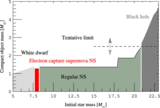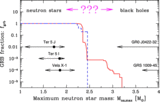Image Details

Caption: Fig. 1.
Comparison of the double neutron star merger rates and short GRB event rates. The solid black line and arrows indicate a firm lower bound on the short GRB event rate (Nakar 2007), based solely on the rate of detected bursts. Depending on the amount of beaming and the fraction of distant faint short GRBs that are missed, the true event rate is often estimated to be at least 10 times larger (Nakar 2007). This lower limit is smaller than the double neutron star merger rate estimated for the Milky Way both from (i) observations of Galactic binary pulsars (filled blue region) and (ii) our population synthesis simulations (filled red region), when these two estimates are extrapolated to cosmological scales. Based on the maximum plausible double neutron star merger rate with the minimum plausible short GRB event rate, the fraction ﹩f_{\mathrm{grb}\,}﹩ of binary mergers that lead to short GRBs should be greater than 10−2 if double neutron stars are the progenitors of short GRBs.
Copyright and Terms & Conditions
© 2008. The American Astronomical Society. All rights reserved. Printed in U.S.A.






